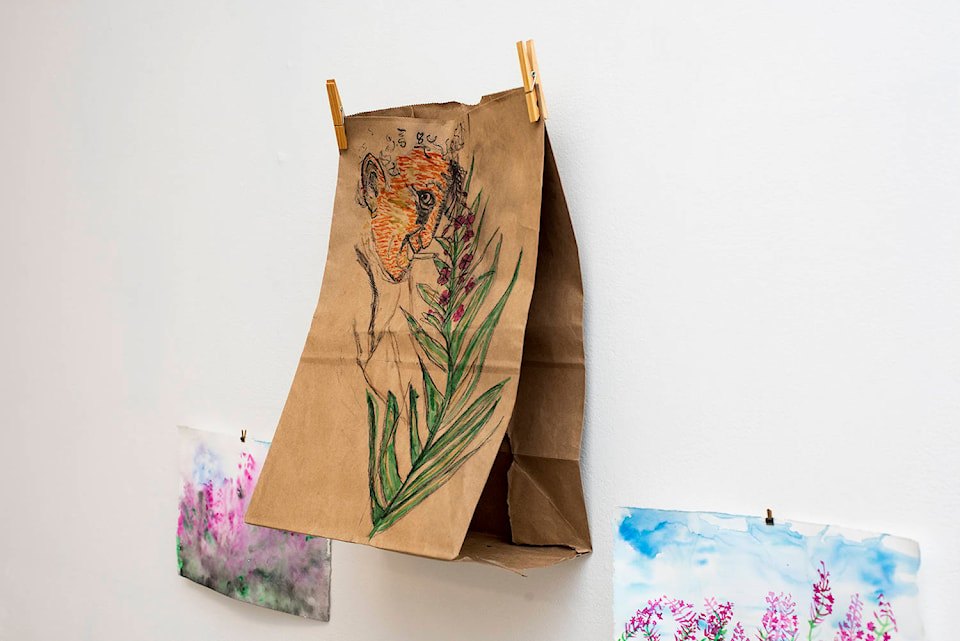Do you have any plants you would consider old friends?
They may not be conventional conversationalists, but this summer artists spent time with more than 30 Dawson-area species to explore their meaning in art. The result is Plant Encounters — an online-accessible project that focuses on the Ninth Avenue Trail and explores our relationship to plants and place through dance, visual art and writing.
In May 2020, Dawson artists Bo Yeung, Georgia Hammond and Meg Walker came together to form the Long Walk Collective.
With a grant from the Yukon government they put out a call for artists interested in making works linked to a specific plant found along trails outside of Dawson City.
The result is an online project that showcases the work of over 30 artists. Each piece was made as a meditation on a specific species, including Lähdzit nänkäk (northern ground cone), Ëläk’ày’ (Labrador tea), Ts’o_̀k (black spruce) and yarrow.
The collective worked with Georgette McLeod of the Tr’ondëk Hwëch’in Language and Heritage Department to incorporate Hän language in the names of the plants.
| Plant Encounters submissions from Jackie Olson created with Kʼàyʼ (willow). (Submitted) |
“You could look at it as a different kind of field guide. It just kept evolving and changing. And the three of us are just so excited to see what came through because it was a very open project,” Walker said.
There was no limit on mediums used. While two artists created a dance pieces, others used painting, staining, 3D animation, sculpture, collage, writing and poetry to express their connections with each plant.
“If you find a familiar plant in an area new to you, it’s like finding an old friend, which is a phrase that (artist) Rian Lougheed-Smith used in her writing, which is about pineapple weed. She called it in her subtitle a ‘common friend.’ It’s such a great way to explain that feeling,” Walker said.
The format of the project, which involved many artists, was also a good way to make sure artists were able to receive funding during the financial challenges of the COVID-19 summer.
Julaine Debogorski, an artist originally from the Northwest Territories who now lives in Dawson, was paired with the Kon’ gu (fireweed).
Her submission is composed of a number of individual pieces — using watercolour, ink prints, text, burned wood and a drawing and painting that incorporated the leaves of the plant.
Debogorski lost her brother to a house fire and said morel mushrooms and fireweeds have been powerful symbols of things that grow after devastation.
“Though it’s sad to think about all the wildlife and the plants that have died, look what’s growing now. The fireweed pops up and all of a sudden there’s this huge splash of colour among a black landscape, what I call a skeleton forest.”
“I’m away from home and I’m probably going to be away from home for a while. Sometimes when you’re away from the place, you start to worry, ‘Oh, am I losing the memory of that person?’ But when I can do these pieces of work it brings me right back. I’ll never lose that feeling,” Debogorski said.
Debogorski said she used Plant Encounters as an outlet to play and experiment with different methods of art, including burning into wood. Not all her experiments ended up in the final work.
“It was a really great part of my summer, a portion of time where I was just creating for the fun of it,” she said.
Artists Michael MacLean and Nate Jones collaborated to create a piece on Kinnikinnick (bearberry) that combines photography with 3D modeling.
The result of their efforts is a “digital sculpture” that was carefully created from photos. While only one photo is present in the final work, it took dozens to capture the necessary detail.
| Inchǫ’ (wild rose) creation by Helen O'Connor for the Plant Encounters online project in Dawson City. (Submitted) |
“It was a process of looking closely,” MacLean said.
While Jones took photos of the plant from multiple angles in Dawson, MacLean was stranded by COVID-19 in Halifax and unable to visit friends and familiar places in the Yukon.
“In some sense it makes me miss the place, the natural world, the Ninth Avenue Trail and those types of things, but because it was also a collaboration working with another artist, I also miss the sense of community around art.
“I find it hard to keep in touch with place and people and friends. But having something to work on like this is kind of exciting because then you have conversations and a way in which you can keep in touch through a project,” he said.
All 30 projects that form the Plant Encounters experience are available to view online at longwalkcollective.org. The website, designed by Jenna Roebuck, functions as a digital gallery.
Visitors can choose to navigate the project by a digital version of the trail, by the pictures of plants or by the names of the artists involved. Next season, after COVID-19 dies down, the collective is hoping there will be a way to also involve the art project on the trail.
“For me the project is a really interesting way to both experience art and experience nature. It’s kind of a beautiful collage, and an attempt to understand a sense of place,” MacLean said.
Contact Haley Ritchie at haley.ritchie@yukon-news.com
